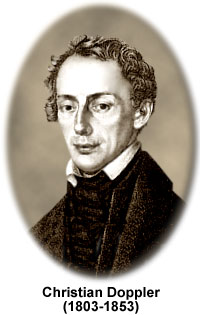Christian Doppler
(1803-1853)

Christian Johann Doppler was a nineteenth century physicist and mathematician who is most often remembered for his discovery of the Doppler effect, which is central to modern conceptions of sound and light. He was born on November 29, 1803 in Salzburg, Austria, the son of a stonemason. Though it was planned for him to enter the family trade, his chronically poor health prevented him from doing so. Instead, he studied mathematics at the Vienna Polytechnic Institute, graduating in 1825. Afterwards, he briefly returned to Salzburg before enrolling at the University of Vienna, where he remained until 1829.
Doppler acted as a mathematical assistant and tutor after completing his studies, but had extreme difficulty in receiving a professorship. At one point he almost emigrated to America in hopes of better prospects, but finally received an offer from the State Secondary School in Prague. A few years later, in 1837, Doppler began teaching at the Polytechnic School located in the same city and was formally appointed to a professorship there in 1841. Then, in the final years of his career, Doppler became Director of the Institute of Physics at the University of Vienna.
Although often occupied with his teaching duties, Doppler managed to find time for independent research. His earliest work concerned mathematics, but in 1842 Doppler completed and published the paper On the Colored Light of Double Stars and Certain Other Stars of the Heavens. Within the work, he proposed that observed frequency of light and sound waves is dependent upon how fast the source and observer are moving relative to each other, a phenomenon commonly referred to as the Doppler effect. He also correctly predicted that his theory would some day be utilized by astronomers to more accurately measure the movements and distances of stars.
Doppler's ideas were initially received with a certain amount of skepticism so, in order to support his claims, he devised an extremely unusual experiment. In 1845, with the help of a colleague, Doppler arranged for a train to carry an open car full of trumpeters back and forth along a section of track. Alongside, another group of musicians stood by and recorded their perceptions of the pitch of the instruments. The innovative test proved successful, confirming Doppler's prediction that as the trumpets approached the musicians heard a higher pitch, which became noticeably lower as the train passed by.
Demonstrating that the Doppler effect also held true for the frequency of light proved more difficult and was never successfully achieved before Doppler's death in 1853. The first experiment that revealed a Doppler shift in starlight was carried out at the beginning of the twentieth century. Since that time, however, the Doppler effect has proven invaluable for astronomical observations, paving the way for a host of new scientific discoveries and concepts. Most notably, the motions of stars detected through this manner led to the development of the big bang theory of the universe.
